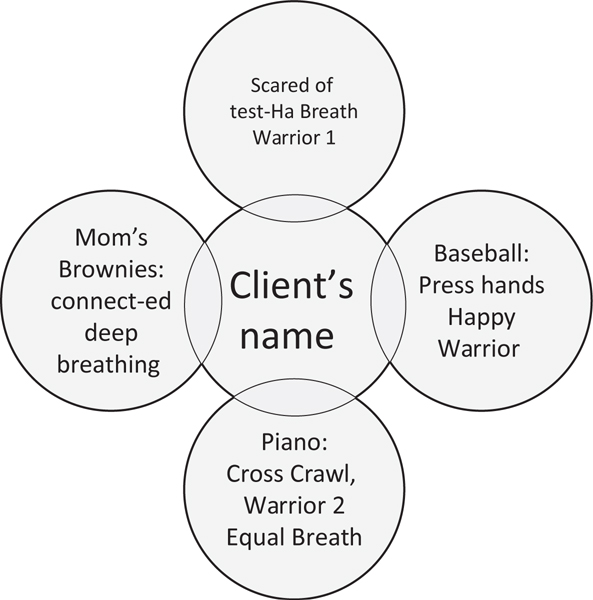
My friend and I were talking while on our daily walk. We were talking about, the Wheel of Awareness, a concept created by Dr. Dan Siegel. She was sharing about her anxiety, hormone imbalances and physiological discomfort. I shared about how feelings are nuanced during the day and how to watch for the nuances rather than wait for the highs and lows. I wanted to give her some options rather than hovering around the same group of uncomfortable feelings of overwhelm. After our walk, we sat in the car with a scrap paper and an orange fine tipped marker and made the “Feelings Circle.” In the middle, I put her name. Along the rim of the outer larger circle, we drew smaller circles. I asked my friend to give me words or feelings that made her happy and brought joy to her heart. She named cooking, puttering, her children, husband, gardening, and moving furniture. I wrote them down and placed the words in the smaller circles. I showed her how she can “shift the wheel” of her mind from the section that describes her anxiety to the more uplifting thoughts and activities.
My friend shared that she loves moving furniture around the house. I explained that moving furniture is a “proprioceptive activity” because it brings feedback through the muscles and joints, which then is calming for the nervous system. Back home, I puttered around, embodying my senses as I unpacked my groceries. I smelled the daffodils, the fresh lemon, and enjoyed the bright red color and smell of the tomatoes. I felt calmer from the proprioceptive walking, carrying groceries and the “puttering” which became a moving meditation. This experience led me to add more somatic, yoga and sensory components while creating the Sensory, Yoga, and Feeling Wheel. The body-based activities can also be used in the classroom to help children become more grounded and act as an antidote to anxiety, fear and discouragement.
In the example below, the top circle demonstrates the child’s anxiety or pre-occupying thought and feeling. This child is scared of a test. In the circles that go around clockwise are thoughts that are positive, uplifting and safe images to counter the negative fear. In all the circles including the top, are yoga and sensory activities to help shift the negative feelings with a body-based repair. All the activities use breathing, yoga and movement to shift the child’s nervous system from the sympathetic to the parasympathetic. All the activities are somatic, layering the sensory experiences into the body on a cellular level as they combine with the breathing.
• You may wish to refer to the section on Witnessing the Mind (Chapter 9).
• Incorporate yoga and sensory components in all circles.
• Record the child’s stressful event, fear or anxiety in the top circle.
• Place in each circle one or two yoga poses, breathing, sensory, or somatic activities
• Elicit from the child three or more positive thought constructs to ground him in safe, enjoyable and pleasant memories or activities.
• Write one positive thought concept in each of the other circles.
• Engage body, mind, and spirit when choosing treatment modalities.
• Place the child’s name in the center of the circle.
• Utilize sensory and somatic activities in the other three circles.
• Moving clockwise, engage in the yoga poses, crossing midline, and proprioceptive activities that accompany the positive as seen in the example.
• The last circle has breath, taste and smell (to foster connection to the limbic brain)
• A restorative pose or Do-Nothing-Doll can be added to aid in the relaxation.

• Do the Ha breath standing or seated.
• Place one leg forward about hip width apart into a comfortable lunge position, front foot facing forward and back foot at 45-degree angle.
• Gently bend knees slightly.
• Inhale the arms up fully, extending the arms up alongside the ears.
• Making the hands into fists, simultaneously while exhaling, pull the arms down, elbows to sides and say “Ha” loudly while bending the knees comfortably.
The Body Mind Centering principle of body halves and brain registration is demonstrated in this activity. Bonnie Bainbridge Cohen, its founder, believes movement and the body inform the brain. While working on a post-stroke patient, Bonnie found that working with the non-affected leg and accessing the same-side brain, gave the patient movement in the affected side. This activity can be facilitated or done by the student independently.
• Share a picture of an outline of the lungs’ shape.
• Starting with the right side, invite the child to push the right palm of hand together against the therapist’s hand on the right side loading the input to one side only. The child can also place her right hand briefly on her own right shoulder. Then remove the hand from the shoulder.
• The therapist gives the client tactile input at the lung of the right side, or the client imagines the lungs and breathes into the lung giving him input.
• Breathe with the awareness of the three lobes.
• Become aware of the right brain half only, and try to access it (same side).
• Practice the activity of moving just the right arm, without crossing midline and stay within the right side of the body half only. Include the right lung as you move, feeling the difference of using the organs in movement.
• Cross midline with the right arm as you access the right side of the brain noticing the difference when you cross midline.
• Make a distinction between one body half first before trying it on the other side. Move slowly, then more dramatically, to get a sense of the body half.
• Repeat on the left side.
• Notice how it feels to access the same side brain half with same side movement. Notice how it feels to access the right side brain and cross midline to the left side movement.
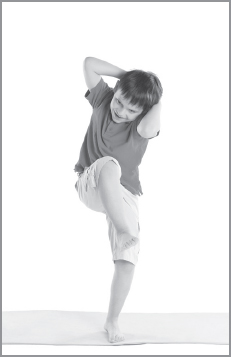
Cross Crawl Pose
• After you have given input with the palms pressing and accessing same side arm, lung and brain half, then attempt this step.
• Imagine the opposite brain side giving strength to the opposite body side.
• Lifting the left knee, bring right hand to touch it, repeat on opposite side, crossing midline.
• Variations include: touch opposite elbow to knee or lifting the bent leg behind the body, and touching the foot with opposite hand.
Yoga poses Warrior series (Virabhadrasana) 1,2,3 and Happy Warrior are all possible poses.
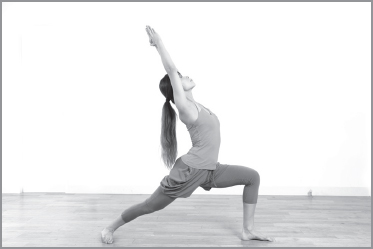
Warrior 1 Pose
Stand with feet and body facing forward. Extend your arms overhead and bend the right front knee as you step backwards with left leg. The front leg deepens with a bend into a lunge position. Maintain the foot and knee in alignment over one another. Extend the arms straight upward. Repeat on the other side.
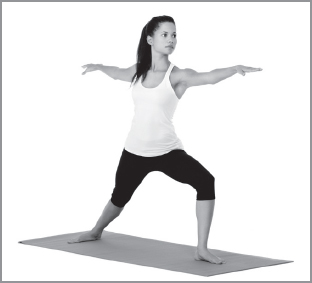
Warrior 2 Pose
Take a wide stance facing the long side of your mat. Turn the front foot to 90° and the back leg to 30-45°. Your feet can be on the mat aligned under your hands. Let your sitz bones sink down and yield the feet into the floor. The back hip turns inward to the navel, and the front hip turns and spirals outward. The line between the feet and up to the sitz bones would make a perpendicular line. Plant the feet firmly as you sink down into the sit bones to ground you solidly. Extend the arms strongly over the feet and yield and bend the front leg sinking into a bent knee pose. The front knee is over the front foot. Repeat on the other side.
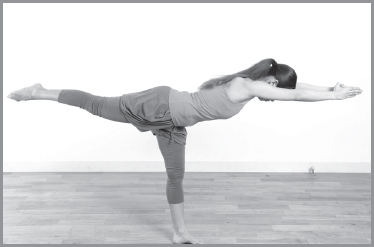
Warrior 3 Pose
Stand in Tadasana or Mountain pose. Inhale, lifting one leg and while exhaling, bend forward and balance on the one standing leg as you extend the opposite leg behind you in the air. Holding your arms extended in front, join the hands, palms facing one another to a full arm extension. Repeat on the other side.
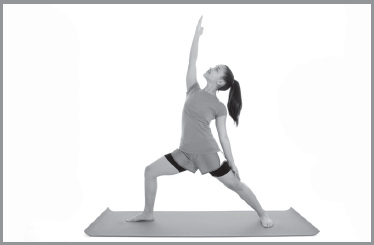
Happy Warrior Pose
Assume the Warrior 2 Pose. Inhale, lifting your front arm towards the sky, move it backwards, with the palm facing you. Take a slight backbend as you exhale and follow your palm with your eyes. Hold the posture. Smile for the Happy Warrior. Repeat on the other side.
• Cross the left leg over the right at ankles. (You may wish to cross right).
• Place your hands, palms facing and touching upward, at chest level.
• Bring your left wrist over the right wrist closer to your chest.
• Turn the palms to face each other and interlace the fingers.
• Touch your tongue to the roof of your mouth and breathe deeply for one minute.
• Releasing the hands and tongue, return to palms-up position.
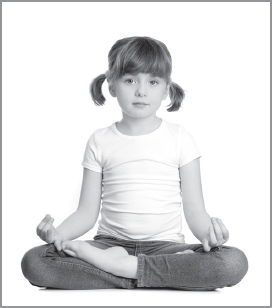
Equal Breath Pose
The equal breath involves silently counting and measuring the length of the inhale and exhale. It is an easy technique for any age. In this image the child is sitting in the Lotus pose.
• Sit in a comfortable position or lie in supine.
• Count to four counts and monitor the length of time as you inhale.
• Count as you exhale for four counts.
• Repeat increasing the inhale and exhale to five counts.
• Continue to increase breath up to six counts. (eight for adults with large lung capacity).
• Auditory cues:
Use clapping hands, tambourine, tapping with pencil or drumsticks.
• Tactile cues:
Add input as the therapist squeezes the client’s hand for each count.
• Verbal
Count to four with your voice or instruct to count silently.
• Visual cue
Imagine a color as you inhale and exhale.
• Imagery cues
Imagine smelling a flower, chocolate or a favorite scent.
• Olfactory cue
If needed, you may wish to have the child smell something in order to participate. Use discretion in choosing a pleasant mild scent that will not distract or be overly stimulating. Maintain that the intention of the activity is to experience an inhale for a determined count of inhale and exhale.
1. Encourage the client to be spontaneous when making up the sensory yoga feeling wheel and the positive thoughts. The therapist might ask, “what are some things that you like to do?”
2. Help students to think of activities that involve a somatic experience. For an example, the therapist can say, “I like how my body feels when I sing, run or bowl.” Then ask the child “What do you enjoy doing that makes your body feel good? Aim for responses that are more about “being and doing” than related to passively watching screens.
3. Add in favorite sensory modalities, deep pressure, vibration, movement.
When working with clients with trauma, the hand mudras and Pranayama exercises are very helpful. You may like to try with clients Activity: Breathe with Embodied Cueing. Give cues to breathe into the abdomen and organs. Suggested activities for a one-on-one session are found throughout the book.
• Guided imagery (See Chapter 3).
• Slow seated chair Vinyasa.
• Hand mudra: Tulip.
• Savasana (Sponge pose).
• 1-2 minute holding of Restorative poses only. Long holds are not indicated for a trauma client. (Legs on Wall).
In this exercise we explore how the body feels moving slowly and shifting weight through the pelvic bones. This is a powerful activity and can bring up feelings especially if you are moving slowly. It can also help with joint discomfort as it unlocks emotional holding. Working slowly can open us emotionally and is grounding. Exploring the pelvic floor and diaphragm is relaxing and helps us to let go of muscular tension. On a chair, pretend you are sitting on a clock. Recognize where the 12, 6, 3, 9 would be located.
• Put hands on hips, and feel the large bones of the two pelvic halves.
• Notice the “sitz bones” or ischial tuberosity, the bony prominence at the bottom of the hipbone, which you are sitting on.
• Gently rock between 3 and 9 o’clock to feel where the sitz bones are located.
• Gently move in the diagonal from 1 to 7 and 11 to 5.
• Gently move slowly around the entire clock, starting at 12 clockwise.
• Use the equal breath to slow down the breathing and bring focused awareness as feelings surface.
• Refer to the Golden Ray meditation, guided imagery or heart meditation.
• Check in with the client about any feelings that might arise from tuning into the pelvic floor which holds many emotions.
This activity is done in pairs and is an opportunity to practice sensing and tuning in to oneself and another person as a partner yoga activity.
Mirroring is a classic activity to demonstrate intuition. Even as an adult, I always am in wonder at the moment that the cognitive gives way to the intuitive and a dance of movement takes place between the two people.
There is always a moment of near panic as I stare at the person across from me, wondering who will be leader or follower. Moving in what appears to be molasses type slow motion, the activity finds its own life and takes over with a leaderless path. It is a way to practice mindfulness qualities in motion. One can practice letting go, beginner’s mind and non-judgment in the exercise.
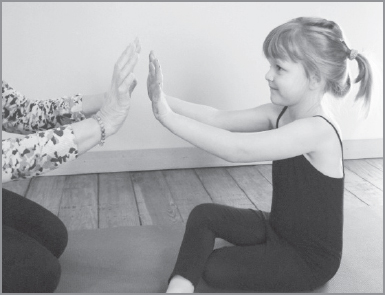
Mirroring Pose
This is a leaderless, physical activity that does not involve touch. The children work with partners and stand or sit facing one another. Instruct the children to place their hands 2 inches apart without touching. This is a moving meditation activity.
• Stand or sit and face one another.
• Both partners begin by placing their palms, fingertips to ceiling, opposite the other’s palms 1-2 inches apart (right hand to the partner’s left hand). The partners do not actually touch physically, but attune to each other.
• Practice being a mirror to one another’s movements.
• Move slowly and simultaneously.
• Act as though you were looking in a mirror. One child may decide to move and the other person follows, then the other may lead.
• Use your senses, feel intuitively when to move or stop.
• Allow this to flow and change from leader to follower simultaneously.
• As one person moves, the other person will sense the next direction.
• Permit a flow to occur where at any time either partner can take the lead.
• Find a rhythm without words where both children mimic one another in a seamless way.
• Go gently from the cognitive to the intuitive.
• See if the kids can notice when they shift to moving together without separation.
This activity is a moving version of mindfulness. It is intuitive and comes from a different part of the brain than the cognitive. It teaches the children to let go, follow their intuitive selves and to have fun. The more one lets go into the leaderless activity the more the task flows with its own rhythm.
The Body Mind Centering principle of “contents and container” allows us to sense the outer structure of the bones and the inner organs. Bonnie Bainbridge Cohen in her book, Sensing, Feeling and Action (1993) explores the organ roll and states: “My experience has shown me that it is imbalances in the organs that underlie many problems that I see manifested in the skeleton, muscles and ligaments.”
Tracing the bones involves touching the actual bone on ourselves so that we can feel where it is located, how hard, large or small the bones are.
• Instruct the children to lie on their back or seated.
• Practice the three-part breath.
• Using fingertips, feel the size and density of the ribs and clavicle (collarbone).
• Notice how the bones move with breath.
• Notice how the ribcage is the container for the lungs.
• Pinch a rib lightly with the first finger and thumb, tracing with the fingertips the ribs from the sternum all the way around to the side and back of the body to the spine.
• Ask the children to notice how many ribs they can trace.
• Draw the ribcage. (Optional).
• Tap on the big bone of the sternum.
• Remember how the water balloon (container) held the water (contents).
• Discuss how the ribs (container) hold the lungs (contents.)
• Notice how the air goes in and out of the lungs and the abdomen.
• Roll to a side-lying position.
• Roll the body slightly more forward or facilitate this for the child. Holding the body slightly forward, but not yet prone, notice how the contents of the organs gently shift.
• Roll back very slowly from the 45° angle to side-lie again and slightly backward. Return to side-lie. Repeat this to sense the organs within.
• Notice how the organs “the contents” shift but are held in place by the bones “the container.”
• If you are facilitating, place the hands over the child’s lower back and abdomen.
This activity works on visual, memory, alertness, following directions, teamwork and attention, motor skills, somatic reactions and verbal skills.
Do it in either small or large groups or in pairs. This can be done in an individual session of therapist and student or in a classroom variation. The goals for this activity are:
• Engage in a quiet activity and feel somatic responses.
• Focus and observe awareness coming through the body.
• Notice wanting to move towards (attracted or reaching).
• Become aware of wanting to move away (pulling or retracting).
• Put your observation into a present moment response.
• Compare thoughts and feelings before after movement.
• Look at pictures or a story that portray different emotional states: happy, sad, fearful, worried, safe, brave, light, and dark.
• Choose images of nature, objects, action, animals, or people.
• Invite children to say what they notice. (Colors, objects, etc.).
• Ask the students these questions:
What do you see that you want to move towards? (Reach)
What do you see that you feel neutral about?
What do you see that you want to move away from? (Pull)
How do I feel when I look at the picture?
• Invite students to take five deep breaths slowly inhaling and exhaling.
• Practice a yoga sequence: Warrior II, Triangle, Tree pose.
• Get on hands and knees. Do a crawl movement.
• Give directions for the Cat and Cow poses (See below).
• Resume sitting.
• Ask the children to pretend that they are reaching for something.
• Pretend to pull away from something.
• Discuss which movement they like better.
• Discuss how the movements feel different in the body.
• Begin on hands and knees.
• Bow the head down, chin in towards the chest.
• Exhale into the pose.
• Round the back up into a dome shape the way a cat stretches.
• Inhale
• Let the chest sink in towards the floor, raising the chin up, let the head go back and look up.
• Repeat Cat and Cow five times slowly.
• Invite the children to stand. (You may wish to do this seated if needed).
• Begin the Golden Ray meditation.
• Sense your legs and feet.
• Place your hands on your hips.
• Feel the bones of the hips.
• Imagine and sense the hip bones connecting to the knees and the heels.
• Imagine a column of golden light going down through the top of the head, the spine, the legs, the feet, down into the center of the earth.
• Feel this sensation grounding the body as you yield into the earth.
• Take three deep breaths with this image.
Present the pictures from the earlier exercise:
• Invite the children to look at the pictures again.
• Ask the students: “Do you notice anything about the picture that you didn’t see before? Where in your body do you feel or notice your reaction?
• Have any of your feelings changed?
• Notice if your mind feels quieter and your body more able to concentrate.”
• Discuss if the movement and the visualization helped.
• Focus on how you feel after these exercises.
Goal: Develop a body (somatic) sense for feeling drawn to something, a neutral feeling, or a sense of wanting to move away. For students to observe and learn when something does or doesn’t feel right to them from information they receive from their own body cues.
1) Give the children a line drawing of a body with no facial features that fills the entire page from head to toe (it can be similar to a stick figure). You can invite the students to draw the heart, spine, pit of the belly (the gut) and the brain.
2) Use different color markers or pencils for this game. One color can be for feeling drawn towards, one for neutral and one for moving away.
3) Present a series of objects, pictures, foods etc. with different textures, colors, sensory inputs smells. Have the students sit in a circle where the objects will be placed. Use some pictures of topics that children or teens would have distinct reactions to such as: bullying, helping someone, littering, students ignoring someone, cliques, driving recklessly, animals etc. Allow for enough space for the kids to engage in movement. You may need to make some lines with chalk or string or indicate where the children can stand for the three states (feeling drawn to, neutral, or moving away).
4) Have the children physically move towards (reach), stay in place or move away from (pull) the object. Have the students notice where they feel a reaction in their body.
5) Instruct the students to draw on the stick figure drawing where they felt the reaction occurred in their own body. Have kids say or write down anything they observe about the feeling in their body and what picture it was related to. Have kids describe if they want to move towards it, stay neutral or move away. Ask the children to discuss where they feel this reaction was in their own body and what is it that they feel.
6) Instruct the kids to do the equal breath. Count out four beats for the length of the inhale. Then exhale to the count of four beats. Repeat his with five beats.
7) Practice several postures such as lunges, forward bends, back bends.
8) Discuss how our feelings are in the body and mind, and how doing the physical postures can quiet the mind especially when using the breath.
9) Review the drawings of where body reactions were located.
10) Discuss why and where the students marked reactions from their body on the stick figure pictures. Look again at the objects and see if anything has changed after yoga.
11) Do they have a calmer response (witnessing) or a more intense response (reacting) after doing the poses?
12) Be accepting of everyone’s experience especially if any students feel resistance to the activity or unable to engage. Remember, we can learn from our resistance as well. Children who have experienced trauma may have difficulty experiencing a somatic response and may need more time.
Tracing bones is done by feeling the bones with our fingers, and following the bone to where it begins and ends.
• Find the large and small bones of the foot without worrying about the names.
• Feel which ones are very big and very small.
• Move the foot and stretch the toes.
• Notice the different parts of the foot and how the bones move.
• Take the time to feel the bones of the foot.
• Stand up and walk around.
• Ask yourself which bones hit the floor first or second.
• Notice if the weight is on the left side or the right.
• Observe if your heel or toe side is more active.
• Sense if both legs feel the same when you walk
• Stop and trace the bones again.
• Notice if anything feels different
• Notice how your weight passes from the hip through the knee and foot.
• Observe how the weight hits the floor while you are standing.
• Standing, place your weight to the outer rim of the foot.
• Shift the weight to the inner side of the foot.
• Shift the weight to the heels and then to the toes.
• Move your attention to the outer rim and square the foot to have four sides
• Consider the foot as a square and feel the weight on all the sides. Go around as if it’s a clock, toes, outer rim, heels, and the inner rim.
• Repeat this several times.
For a quick focusing activity, have the child tap on the manubrium, the broad upper part of the sternum. The sternum is the big bone that the ribs attach to on the front surface of the body. Start by finding the soft hollow part of the throat. Feel the manubrium, the bone at the top of the sternum at the level of the clavicle (the collar bone which is on top of the first rib). Children and adults will be amazed how hard this bone is. Tapping is also a way of awakening the senses because the thymus gland is in this area.
Tuning into the skeletal system is a simple activity to help children see how quickly the mind can cease from wandering. Each tap gives a proprioceptive jolt and wake up call to our mind and body. This allows us to feel the structure the bones provide us and come into the present moment. It supports our thoughts to become grounded through the sense of the layers of the bones. It can teach us to focus as we bring our awareness back to the large bones.
The thymus is part of a group of glands called the neuro-endocrine system which runs through the center of the body. This system separate yet similar to the energy of the chakra’s is a subtle one but has a profound impact on the body. We can benefit from acknowledging the subtle existence of the two systems of chakras or energy centers and the glands which correspond near one another. These two systems can be helpful in understanding more about the emotional component of the yoga poses. The thymus, which defends against disease, is larger in childhood and involutes, or shrinks, at puberty. Linda Hartley, author of Wisdom of the Body Moving writes:
The thymus plays an important role in the body. As part of the lymphatic system, the thymus energetically helps create the sense of personal boundaries. The experience of loss of boundaries and protection often accompanies a breakdown of the immune system; stimulation of the thymus gland can help to strengthen the weakened boundaries and facilitate the transformation of fearful feeling into courageous action. It has a relationship to the adrenals, the center of instinctive courage. The thymus gives support to the shoulder joint and shoulder girdle and openness across the front of the chest. It moves the body forward and upward and the open posture itself expresses a courageous state of mind. (p.218)
We can all relate to courage and focus. It helps us to bring the mind back to the task at hand.
Placing your index and middle finger tips on the manubrium, tap gently but firmly on the hard bone, which overlies the thymus. Feel how your body responds to this activation.
You can also try walking while tapping. Sense your experience of courage and forward direction, the support through the shoulders and the openness of your chest. Allow your subtle feeling to develop as you practice this.
• The heart center is in the area around the thymus called Anahata chakra. A chakra is an energy center in the body. Back bends are about growing bigger and opening the heart. Benefits include: Opening the heart center and lungs.
• Toning the spine
• Energizing the body
• Waking up the nervous system
Combine the backbend with the thymus awareness of courage and openness.
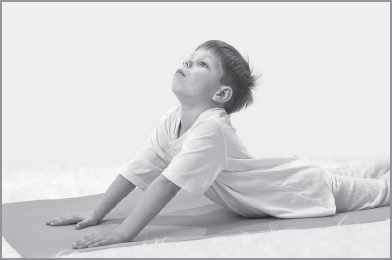
Upward Dog Pose
When we do Upward Dog, we will take the support of this pose from deep in the pelvis, the organs, and up through the heart and lungs. Instead of pushing out with the heart, allow it to soften and rest yielding or allowing the arms to melt into the floor permits the body to rise as we reach with the head into the backbend and press up. Hold the arms straight and the chest and hips off the ground.
Tapping the thymus can help focus students in a busy hallway or lunchroom.
• Can you be patient with your own body and its pace?
• Can you be patient with the pace the teacher wants you to walk?
For kids with sensory processing issues, being patient can be a challenge when they want things to happen faster or are uncomfortable in their own bodies. The bones can be used as a grounding tool, offering structure, and can help sensory kids to focus internally in a positive way.
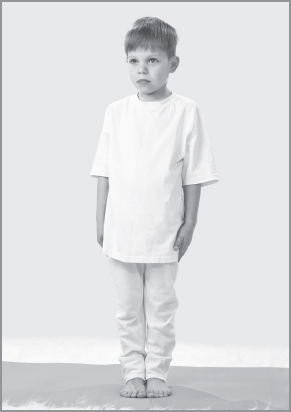
Mountain Pose
Tadasana, the Mountain pose is a quick line-up exercise before the children have to walk through halls to the lunchroom.
• Stand in Mountain pose
• Invite the student to stand tall as a mountain.
• Embrace the quality of effortlessness.
• Maintain the natural curves of the spine.
• Relax instead of striving.
• Allow your weight to yield down through the bones of the spine and pelvic halves into the ground and feel the support of the whole body.
• Stand quietly in Tadasana.
• Experience the awareness of the Witness (the part of us that is aware of ourselves being aware)
• Stand tall as a mountain and find a place in your body that feels comfortable.
• Stand up with a feeling of lightness and ease, without stiffening.
• Relax into a place where you are balanced in your feet and your weight is evenly distributed.
• Allow a sense of melting to take the weight through the body into the ground.
• With a deep breath, raise your arms overhead, or you can leave your arms at your sides.
• Breathe gently and easily.
• Provide a structure of acceptance, trust and non-judgment when exploring the embodied activities.
• Hold each student’s experience with the utmost gentleness and openness.
• Know that the embodied activities may activate feelings that are not on the surface.
• Be tolerant of all responses, resistance, silliness, or non-participation.
• It isn’t beneficial to force any students to participate.
• Give clear structure and a safe option for those who don’t wish to explore.
• Be kind to yourself as the instructor and patient with the students’ reactions.
The embodied modalities and explorations have multidimensional benefits for students. Even the students who sit on the sidelines resistant will have an experience to feel that resistance in the body. For the students and teachers who embrace the embodied activities, the learning opportunities are vast. Embodied learning merges mindfulness, meditation, somatic experience, internal sensing, Pranayama and witnessing the mind and emotions. For trauma clients, it allows a “door in” to deep-seated emotions. To learn to connect what you feel in the body with what you sense in the mind and emotions is a powerful tool that can help adolescents make critical decisions. We owe it to our students to teach them these imperative skills.